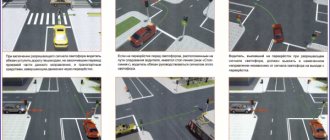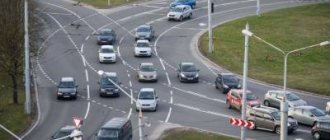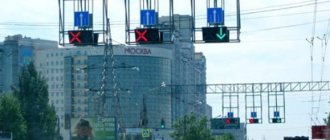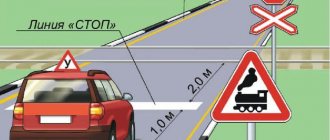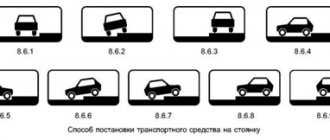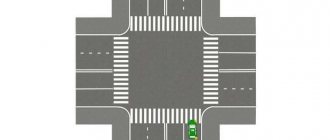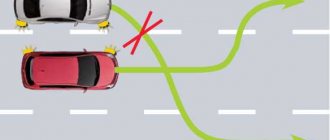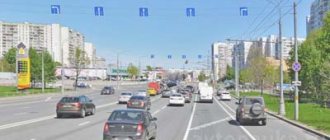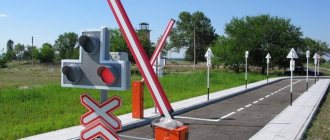The current Traffic Rules were created in order to streamline the movement of vehicles and more, make it safer and reduce the accident rate. But the constant addition and change of rules cannot but confuse motorists. Plus, the interpretation is not always clear to everyone. This is especially true for drivers who have only recently been behind the wheel.
If, in principle, no special problems can arise when passing a regular traffic light with 3 signal lights, then the presence of additional sections raises a number of questions and ambiguous reactions.
Paragraph 6.4 of the traffic rules states that if there is a black contour arrow on the main green traffic light signal, it informs about additional sections and indicates a different permitted direction of movement than the signals on additional sections.
Not all car enthusiasts know and understand how to act in a given situation, and what needs to be done if there are additional sections. This issue requires mandatory detailed consideration, which will allow you to act as correctly and accurately as possible.
What does this traffic light look like?
Even those who have never driven before know the standard traffic light signals. Red, green and yellow lights indicate the need to stop or start moving. And here everything is extremely clear. But not all motorists have yet figured out the additional section.
The first step is to understand the difference between traffic lights with additional sections and directional traffic lights. In the case of the latter, the arrows indicate a ban or permission to start driving on certain lanes or groups of lanes. Moreover, each individual arrow is responsible for movement specifically in its own lane.
Not all motorists understand why an additional traffic light section is needed and how to interpret the presence of such an element with an arrow straight, left or right. The additional section, unlike the directional traffic light, is responsible for the ability to turn from the main lane to the right or left. Such solutions are used to relieve overly busy intersections. When passing a special traffic light equipped with an additional section, the driver is given a hint when he can turn left, right and continue driving.
With sufficient experience and knowledge, such traffic lights really help motorists significantly. But for beginners they cause a number of problems and difficulties.
The rules for driving in areas where traffic lights with additional and prompting sections are installed directly depend on the combination or combination in which these windows light up. To do this, you should look at the traffic rules and find out what the current Traffic Rules say about this.
It is not difficult to imagine a classic traffic light with three windows (red, green and yellow). At the level of the green window there may be 1 or 2 additional sections. This is the most common option. Although there is another situation where the section is located at the level of the red traffic light. We will also talk about it separately.
Most often, motorists for whom additional sections of a working traffic light cause difficulties and concerns are faced with several situations. It’s worth talking about them in more detail:
- additional sections are disabled;
- the additional section is on, and at the same time the green signal of the main traffic light is on;
- It's still on, but the traffic lights are red.
It is necessary to study all types of traffic lights and consider situations associated with an additional section. This will allow you to understand how the driver should behave in a given situation. If you look into the issue, it turns out that there is nothing complicated in this matter.
Turn right or make a maneuver
- The main round element of the control device is active.
- An additional traffic light section to the right and a green light in the main section give you the advantage on the road. You don't let anyone through, everyone lets you through.
- When the auxiliary element is active with a picture of a turn in the direction you want and a red or yellow signal is on, you should let all cars pass, regardless of their direction, and only after that continue your path by turning right.
You cannot ignore the rules for passing traffic lights with an arrow. This will result in a fine. Please note that turning in the direction of an inactive arrow is equivalent to driving through a red light at a regular traffic light that does not have auxiliary elements. For the first violation you will have to pay a thousand rubles. In case of repeated violations, the amount increases to 5 thousand rubles and you can even lose your rights for a period of 4 to 6 months.
Such measures to combat violations of traffic rules will serve as a serious incentive for a detailed and careful study of traffic rules that regulate the passage of traffic lights with additional regulatory blocks.
Be careful and do not create dangerous situations on the road. If everyone listens to this, then moving on the roads of Russia will become much safer and more enjoyable.
Additional section prohibits movement
When approaching such a traffic light, you can see that the side windows or side sections are not lit, or they glow a prohibitory red color.
Everything here is extremely simple. When a section is not lit or is lit but red, moving in the direction the arrow is pointing is currently prohibited.
In such a situation, it makes no sense to look at the color of the main traffic light or in which direction the additional section arrow is turned. If it is disabled or highlighted in red, you cannot move in that direction under any circumstances. You should wait for green.
Arrow and green signal
Let's consider a different situation when the traffic light signal, as well as the additional section of the device with the arrow itself, are green. And here the actions of drivers depend on the specific situation. Or more precisely, from what the traffic light itself looks like:
- the device has only one side arrow (left or right, respectively);
- There are two arrows on the device at the same time, pointing in lateral directions.
It is not difficult to guess that the left section will be responsible for turning left, and the right section will be responsible for turning right.
There are two ambiguous situations here related to how to drive a road section correctly in one case or another. Look at which side allows you to turn further.
- The right additional arrow is lit green, the traffic light is green. If you need to move to the right, then in this position the additional section with the arrow of the main traffic light allows you to perform the maneuver. Pay close attention to the additional signal arrow. In this situation, the motorist has the right to turn to the right. Only pedestrians crossing the roadway in the direction in which the driver is turning are required to give way. But most often, traffic lights at an intersection work in tandem, and in such a situation, pedestrians will see red.
- The left additional section is lit green, but the current color of the main traffic light is red for the driver. In such a situation, it is possible to turn left. Usually there should be no obstacles in the way of movement and there is no need to give way. In countries with right-hand traffic, which includes Russia, the left side is often used as an unloading lane. Other traffic participants at this moment cannot drive in the direction of the turn you are making. But there is one exception. When a vehicle moves straight in the oncoming lane or turns to its right, you must give way to them.
But this is far from a complete list of situations that a motorist may encounter.
What should a driver do when changing such a traffic light?
| 1. | When the red signal turns on, turn right, giving way to other road users. |
| 2. | When the green signal turns on, continue moving only to the right. |
| 3. | The above actions are correct in both cases. |
The traffic light signal in the form of a yellow arrow informs you that only right-hand traffic is allowed from this lane. You can make a turn after turning on the signal in the form of a green arrow.
Additional green arrow parallel to the red traffic light
Quite often, beginners who have recently found themselves behind the wheel are frightened by the red color of the main traffic light, despite the presence of additional permitting signs giving the go-ahead to perform the maneuver. As a result, such a car can stop all traffic.
Imagine a situation where an additional light in front of you lights up or is glowing green, pointing to the left or right side of the movement. But the traffic light itself is red. This is very confusing for some drivers, and they believe that driving is prohibited for them. But it all depends on which direction you are moving. This situation indicates the possibility of making a turn in the direction in which the green additional arrow is pointing. But you must give way to motorists driving in other directions.
Despite the fact that the traffic light is red, the presence of a green light in the additional section gives the right to turn in the direction indicated by the arrow, without waiting for a green signal from the traffic light itself.
As for the need to give way, then we are talking about not creating interference. Do not start, continue or resume driving if this requires other drivers to slow down or change the direction of their own movement. Roughly speaking, when, because of your maneuver, other drivers slow down or change their trajectory, this indicates a violation of traffic rules on your part, since you played the role of an obstacle.
The rules do not clearly state which vehicle, depending on the direction of their approach, you must yield to. It's not worth the risk in this situation. It is better to make it a rule that you need to give way in situations where the traffic light is red, but the additional section is green.
The combination of a green additional signal and the main red signal exclusively indicates the ability to move in the direction where the additional section indicates. You just need to remember that in such a situation you do not have a priority or primary rule. It is for those motorists in front of whom the green traffic light is on at the same time and the green arrow has reached the signal. Therefore, it is they who are required to give way, and also not to interfere with other traffic participants, carrying out a maneuver of this kind.
Collision when turning left on a yellow traffic light
Due to the high volume of traffic, drivers turning left at a signalized intersection are forced to perform the maneuver in two steps.
First, drive out to the middle of the intersection and, stopping, let oncoming traffic pass.
In the second phase, after the traffic light switches to yellow (red), they complete the left turn.
It is the switching of the traffic light signal from green to prohibitory yellow that creates confusion.
Each driver in this situation interprets the Russian Federation traffic rules in his own favor.
For one driver, the Rules establish the obligation to give way to all vehicles moving towards and to the right.
The other driver, when the yellow traffic light prohibiting traffic turns on, according to the Rules, must stop driving and stop before entering the intersection.
Regardless of the fact that the signal at the traffic light has switched from allowing movement to prohibiting, vehicles that entered the intersection when the signal is green must leave it - clause 13.7 of the Russian Traffic Regulations.
At the same time, a car moving in the opposite direction, entering the intersection when the green light is on, must complete its movement in the intended direction.
Therefore, a driver who is about to make a left turn, in fulfillment of the safety requirements for the maneuver he is performing, must give priority in movement to the driver of a vehicle moving through or entering an intersection in the manner prescribed by clause 6.14 of the Russian Federation Traffic Regulations.
In other words, a driver making a left turn at an intersection must let all traffic moving towards him pass and wait until the traffic stops completely after the traffic light turns yellow. Only after this the driver can make a left turn.
In the vast majority of cases, despite the obvious nature of mutual guilt (at a minimum), drivers making a left turn are found guilty of such accidents.
Moreover, such qualifications of drivers’ actions may change when appealing a traffic police decision or during the consideration of a civil claim.
An example of such a situation can be seen in the video recorded by a dashcam camera installed on a car completing a turn maneuver when the traffic light is yellow.
The nuances of moving straight
Separately, it is worth considering the situation when a motorist needs to move straight, and a traffic light with an additional section appears in front of him.
In such a situation, direct movement is only permissible in 2 situations:
- the driver who is about to drive straight sees the green light of the main traffic light;
- The driver's main light is green and the additional green light is on.
If the main signal is currently red and the arrow is green, then driving in a straight line is prohibited in this situation. There is nothing complicated here, because motorists often have no problems with direct passage of a traffic light that has an additional section.
Traffic light with an additional section: rules for driving straight ahead
It is possible to move straight ahead, seeing a traffic light with additional arrows in front of you:
- If the main traffic light is green.
- If the main green signal is on and the additional arrow is on green along with it.
In the case when the main signal is red prohibiting, and the arrow glows green, you naturally cannot move. These are the simple rules for driving straight to a traffic light with an additional section.
Inspection with inactive arrows
Not so often the traffic rules deal with the issue that concerns the passage of traffic lights equipped with auxiliary sections, where the side windows themselves do not light up. That is, the arrows are inactive. This causes some difficulties for motorists; they stop, wait for a signal, and delay other road users.
Imagine that a car is approaching an intersection and the main traffic light turns green. But the side section remains inactive. The red or green arrow does not light up on it. In this situation, there is no need to panic and wait until it becomes active. According to the rules, you are allowed to calmly carry out the planned maneuver.
Green arrow at red signal level
It is equally important to consider a slightly different situation, when an additional section is present, but is not at the level of the green signal, but is located directly to the left or right of the red light of the main traffic light.
A similar version of a traffic light appeared relatively recently. Structurally, this is a classic traffic light with 3 lights, complemented by a sign with a graphic image in the form of a green arrow. Depending on the location, she looks to the right or left.
The main distinguishing feature of such a traffic light is precisely the level of location of the sign. If in the case of additional sections that light up red and green, they are mounted at the level of the green traffic light, then the sign is attached near the red signal.
Such a relative innovation is regulated by two points of the traffic rules. These are 58.4 and 20.1.
The interpretation of a motorist’s actions directly depends on which direction the auxiliary sign is directed.
- The sign with the green arrow is pointing to the right. If the traffic light itself is red, then the motorist is required to stop in accordance with the rules of the prohibiting signal. But then you are allowed to continue moving and maneuver. The driver must first make sure that his maneuver is safe. Movement continues carefully, avoiding interference with other vehicles moving in their priority direction. Also, a driver turning on a green sign at a red traffic light is obliged to let all pedestrians pass when turning right. At this moment the light is probably green for pedestrians.
- The sign with the green arrow is directed to the left. This is possible on sections of a one-way road. Here, as in the previous case, you need to stop your vehicle before the red signal. After this, adhering to the rules of safe movement and preventing interference, start moving to the left. Such a maneuver is permitted only after the vehicle has come to a complete stop and exclusively from the leftmost lane. Before turning left, the driver undertakes to allow all pedestrians and other vehicles to pass according to the principle of priority.
These points should definitely be taken into account when approaching traffic lights of this type. This will help protect yourself not only from unwanted fines, but also from accidents, accidents and other unpleasant incidents on the road.
Traffic lights with green arrow
Continuing the topic, we cannot help but consider another type of traffic lights that appeared quite recently. This is a regular three-color device, where a sign with a graphically depicted green arrow is attached at the level of the prohibitive red section. This innovation is regulated by clause 20.1 and clause 58.4 of the Traffic Regulations.
Let's look at them in more detail:
- At the red signal level there is a sign with a green arrow to the right. In this case, you need to stop the car at the red signal. You are then allowed, after making sure that the maneuver is safe, to carefully continue moving in the direction of the arrow. In this case, you can move only from the far right lane, without creating obstacles for other vehicles, whose movement in this case is a priority. Give way to all pedestrians walking towards the permitting signal before the maneuver.
- At the red signal level there is a sign with a green arrow to the left (one-way traffic). You should also stop the vehicle before turning on the red signal, and then, taking precautions, it is possible to maneuver to the left. Driving is possible only after stopping and only from the leftmost lane. Before the maneuver, it is necessary to allow pedestrians and other vehicles, whose movement is now a priority, to pass.
Here we have looked at all the features and nuances of driving at a traffic light with additional sections. Such devices do not complicate, but rather facilitate movement, only at first causing confusion in the driver’s head.
6.1. Traffic lights use green, yellow, red and white-lunar light signals.
Depending on the purpose, traffic light signals can be round, in the form of an arrow(s), a silhouette of a pedestrian or a bicycle, or X-shaped.
Traffic lights with round signals may have one or two additional sections with signals in the form of a green arrow(s), which are located at the level of the green round signal.
6.2. Round traffic lights have the following meanings:
- A green signal allows movement;
- A green flashing signal allows movement and informs that its time is expiring and a prohibitory signal will soon be turned on (digital displays can be used to inform drivers about the time in seconds remaining until the end of the green signal);
- The yellow signal prohibits movement, except in cases provided for in paragraph 6.14 of the Rules, and warns of an upcoming change of signals;
- A yellow flashing signal allows movement and informs about the presence of an unregulated intersection or pedestrian crossing, warns of danger;
- A red signal , including a flashing one, prohibits movement.
The combination of red and yellow signals prohibits movement and informs about the upcoming activation of the green signal.
6.3. Traffic light signals, made in the form of red, yellow and green arrows, have the same meaning as round signals of the corresponding color, but their effect extends only to the direction(s) indicated by the arrows. In this case, the arrow allowing a left turn also allows a U-turn, unless this is prohibited by the corresponding road sign.
The green arrow in the additional section has the same meaning. A switched off signal of an additional section or a switched on red light signal of its outline means that movement in the direction regulated by this section is prohibited.
Directions of movement at different traffic lights with one additional section (arrow)
Driving directions for different traffic lights with two additional sections (arrows)
6.4. If a black contour arrow(s) is applied to the main green traffic light signal, it informs drivers about the presence of an additional section of the traffic light and indicates other permitted directions of movement than the additional section signal.
6.5. If a traffic light signal is made in the form of a silhouette of a pedestrian and (or) a bicycle, then its effect applies only to pedestrians (cyclists). In this case, the green signal allows, and the red signal prohibits, the movement of pedestrians (cyclists).
To regulate the movement of cyclists, a traffic light with round signals of reduced size, complemented by a rectangular white plate measuring 200x200 mm with a picture of a black bicycle, can also be used.
6.6. To inform blind pedestrians about the possibility of crossing the roadway, traffic light signals can be supplemented with an audible signal.
6.7. To regulate the movement of vehicles along lanes of the roadway, in particular along those in which the direction of movement can change to the opposite, reversible traffic lights with a red X-shaped signal and a green signal in the form of an arrow pointing downwards are used. These signals respectively prohibit or allow movement in the lane above which they are located.
The main signals of a reversible traffic light can be supplemented by a yellow signal in the form of an arrow, tilted diagonally down to the right or left, the inclusion of which informs about the upcoming change of signal and the need to change lanes to which the arrow points.
When the signals of the reversing traffic light, which is located above the lane marked on both sides by markings 1.9, are turned off, entry into this lane is prohibited.
6.8. To regulate the movement of trams, as well as other route vehicles moving along the lane allocated for them, single-color traffic lights with four round white-moon colored signals located in the shape of the letter “T” can be used. Movement is permitted only when the lower signal and one or more upper ones are turned on simultaneously, of which the left one allows movement to the left, the middle one allows movement straight, and the right one allows movement to the right. If only the top three signals are on, then movement is prohibited.
Important rules from traffic rules
If we talk about the situation with the rules for passing traffic lights with additional sections, then it is worth focusing on several key rules provided for in the traffic rules.
They can be called fundamental. Based on them, every motorist will be able to make the right decision in a given situation. The main excerpts are as follows:
- Arrows that are red, green or yellow are absolutely equivalent and correspond to the main colors of a standard traffic light equipped with round sections. But the arrows are solely responsible for movement in the direction they point to.
- If the arrow points to the left, this gives the driver the right not only to turn left, but also to make a U-turn. But this is only possible if such a maneuver does not go against a specific road situation. When other circumstances allow you to turn around, the driver, if there is a left arrow, can perform the appropriate maneuver.
- When the arrow has a green current color, but is combined with a main yellow or red prohibition signal, then before turning, motorists are required to give way to all vehicles traveling in the priority direction.
- If we are talking about a tram that moves according to the permitting green arrow on an additional section, but the main traffic light is red or yellow, the tram also undertakes to give way and act on the principle of giving priority to other cars.
Based on these points, it will be much easier to understand the peculiarities of crossing a traffic light that has additional sections. Don’t be lazy to periodically re-read the traffic rules, study the latest publications and actively follow innovations in matters of traffic rules.
